Eliakim Wardell: Monmouth Beach Founder
The founder and first settler of the New Jersey coastal area today known as Monmouth Beach (other than the true first settlers, Native American Indians) was a man named Eliakim Wardell. Area residents should remember and respect this man for starting such an awesome community — all beginning as “Wardell’s Beach” some 350 years ago.
Born on November 23, 1634 near Boston, Wardell was a Quaker (known as the Society of Friends). His father, Thomas, had immigrated from England. His mother was Elizabeth Woodruff.
Eliakim and his wife, Lydia (they married in October 1659), were persecuted, whipped, imprisoned, and ultimately banished from New Hampshire by the Puritans for their religious beliefs. Lydia, the daughter of Isaac Perkins and Susannah Wise, was particularly combative in her protests, “appearing naked in Newbury as a ‘sign’ unto her persecutors who had stripped women to whip them.” Ultimately, the couple fled to Rhode Island where things on the religion freedom perspective improved somewhat.
In 1667, hearing word that large tracts of undeveloped land were able for low cost and limited taxes, Wardell and wife (they would go on to have 7 children) came to what would become Shrewsbury Township located in Monmouth County (NJ was then a British colony). About that time Wardell was named an associate of the Monmouth Patent group, the first area developers, which was formed in April 1665. That land grant was signed by Governor Richard Nicolls, who was in fact the English governor of New York (NJ was then part of New York). Both Nicolls and the patent guaranteed settlers “liberty of conscience without any molestation or disturbance whatsoever in their way of worship.”
“If Eliakim Wardell could see his farm today, he would be astounded by the change but would also realize the spirit of neighborliness that he left behind is still there.”
—Rosemary O’Brien, Monmouth Beach: A Bicentennial Publication 1975
The Beginnings
According to the historic timeline, Shrewsbury Township was officially formed in October 1693. In February 1849, Ocean Township separated from Shrewsbury and in March 1906, Monmouth Beach separated from Ocean Township.
According to the Monmouth County Historical Association, the county was first settled by migrant New Englanders in 1664. Monmouth County was considered a very desirable area for its abundant “shoreline and estuaries which provided a bounty of clams and fish, and the rich soil of the interior lowlands that provided varied and generous agricultural products.” Monmouth County was officially formed in 1683 by the Proprietary Assembly, and was named after Monmouthshire, England.
In May 1668 according to local folklore, five associates of the original Monmouth Patent holders from 1665 (Wardell, John Slocum, Jasper and Peter Parker and George Hulett) sought to resolve a land acquisition dispute with local Indians. Starting at dawn at a spot near today’s North Broadway in Long Branch, Slocum engaged in a “two falls out of three” wrestling match with Lenape tribe member Vow-a-Vapon. Under the terms, if Slocum won he could buy all the land that he could “walk off” in one day. If he lost the group left with nothing. A man of “great size and strength,” Slocum won a tough match — defeating an opponent who was covered in a “coat of goose grease.” Slocum got Long Branch, the Parker’s took Rumson/Little Silver, Wardell received Monmouth Beach/Sea Bright, and Hulett disappeared.
The Slocum account is cited in the 1940 Long Branch city-bio book, Entertaining a Nation. It comes from history complied by the Rev. D.V. McClean of Red Bank, according to A Complete Descriptive Guide of Long Branch, NJ by J.H. Schenck, 1868.
Surprisingly enough, settlers had little interest in the seashore in those early days, with most Jersey Shore pioneers thinking it practically worthless.
Little For a Lot
Wardell then bought the rights to the area that is now considered Monmouth Beach (about 454 acres including Sea Bright) from the Lenape tribe for the equivalent of 4 pounds (about 11 cents per acre). He paid in blankets, clothing and hardware for all the land north of Long Branch, below Sandy Hook, and between the Shrewsbury River and Atlantic Ocean.
The area known as “Fresh Pond” was called “the most fortuitous land grant of all,” according to the book, Up and Down the Beach by June Methot. And unlike other land deals of the time “there never was much question as to the ownership” by the Wardell family, which would hold clear title to the property for nearly 200 years. “Wardell’s Beach” was a regular location on most maps of those days.
Obviously a person of influence, Wardell was appointed the first Sheriff of Monmouth County in May 1683 (he was called a “Royal Sheriff” and served for 6 months). Prior to that he had been a deputy representing Shrewbury in the General Assembly. (New Jersey wouldn’t join the union until December 1787.)
Wardell built the first structure in Monmouth Beach. Construction materials included massive stones previously used as ballast on ships coming to America from Great Britain. Originally know as the “Wardell farmhouse,” the high-ground subsequently became the Monmouth Beach Clubhouse Hotel, an exclusive coastal resort and vacation hotspot for Glided Age tycoons in the late-1800s. A fire destroyed the main structure in December 1929, but parts of its still survive today on Beach Road and River Avenue.
Wardell died in 1710 in Burlington, NJ. Many of his descendants (Joseph, John, Ebenezer, Jacob, and Henry Wardell among them) would go on to live in and around Monmouth Beach and help shape our coastal area.
According to Monmouth Beach: A Bicentennial Publication (1975) by Rosemary O’Brien, the lineage of MB ownership for the Wardell family is that Eliakim’s son Jacob remained on the farm. Jacob’s son Peter, left and came back to MB. When Peter died the farm then went to his son, Benjamin (1763-1821). Benjamin’s son Henry was the next to own the tract. Henry was a very busy fellow — in 1842 he built the Ocean House (in today’s Sea Bright), the first hotel at the Jersey Shore. He also donated property for the U.S. Life-Savings Service station in 1849.
Sadly, to my knowledge, there is no official recognition of Wardell or his family in the entire borough of Monmouth Beach today.
More:
• Long Branch Beginnings — HERE
• Sea Bright Beginnings — HERE
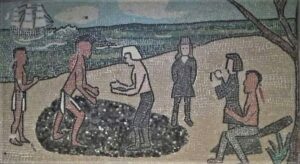
Slocum wrestling match in mural from, 1668. The mosaic was done by West End School students (Beth Anne Duze Woolley Photo).
More Info:
• A Complete Descriptive Guide to Long Branch, NJ by J.H. Schenck, 1868
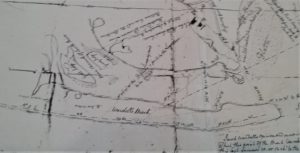
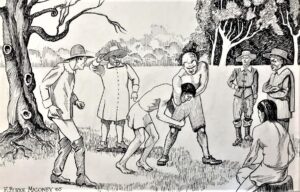
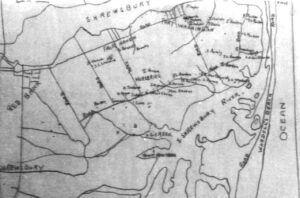
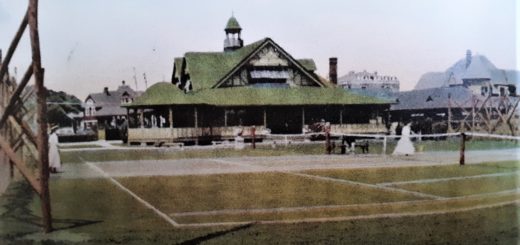
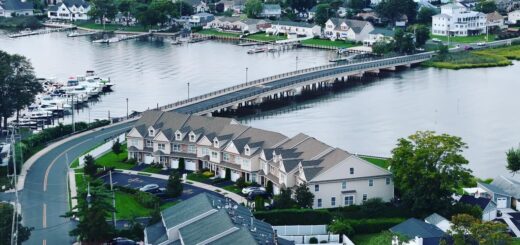
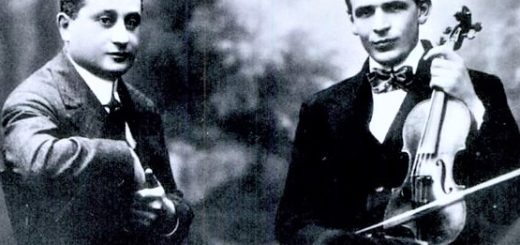


Thank you so much for this article and the others within your series. It was such a treat to read that Eliakim and Lydia are remembered for settling the area first. I knew it … my husband’s family are direct descendants through Eliakim and Lydia’s daughter Margaret (Wardell) Allen who married William West. Many of us still reside within Monmouth County. I look forward to reading the rest of the articles. Again, thank you!
Thank you for this article. Descendant of Samuel Wardell and John Slocum’s brother Nathaniel.
Thank you for the article. I am a descendant of Eliakim Wardell (my 10th great grandfather).
I am looking for any books published about the Wardells’ for my nephews birthday gift.
Thanks.
This was a great article. I love reading about the history of the Wardell family. Eliakim Wardell would be my 7th great grandfather.
Two Wardells were Chief of Police in Neptune, NJ. One, was a friend, from kindergarten to graduation, of my father. He is also our cousin. The Wardells are related to many of the first families of N.J.
Thank you for this article. I’m a direct descendant of Eliakim and Lydia.
Eliakim was my 7th Great Grandfather. I come through his son Joseph Wardell (born 1660 in New Hampshire) and his wife, Sarah Bonnell. The history of Wardell/Perkins families encompasses almost every major event in North America. The courage of Eliakim and Lydia for their religious beliefs should be highly regarded by today’s society.